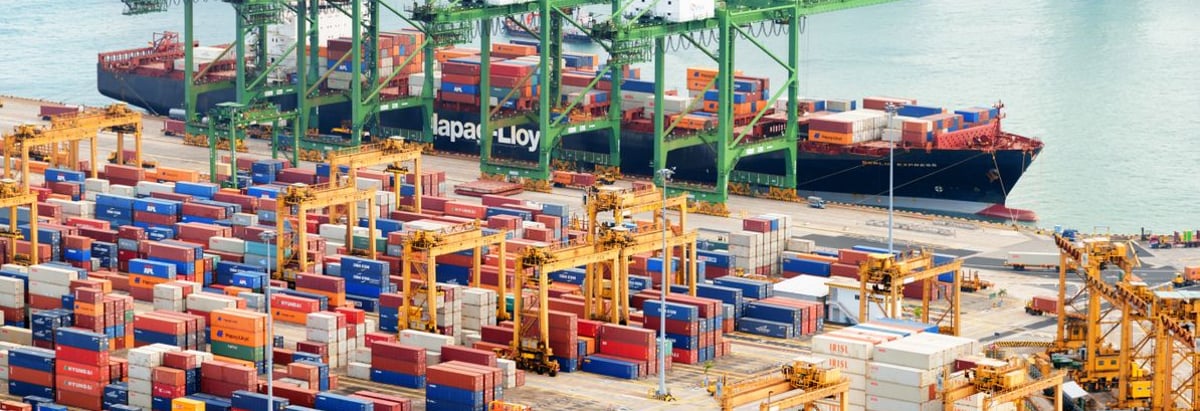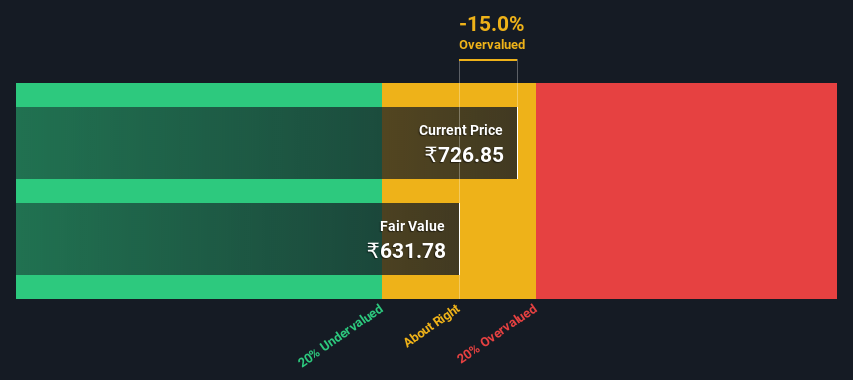- India
- /
- Infrastructure
- /
- NSEI:ADANIPORTS
Estimating The Intrinsic Value Of Adani Ports and Special Economic Zone Limited (NSE:ADANIPORTS)

Key Insights
- The projected fair value for Adani Ports and Special Economic Zone is ₹632 based on 2 Stage Free Cash Flow to Equity
- With ₹727 share price, Adani Ports and Special Economic Zone appears to be trading close to its estimated fair value
- Our fair value estimate is 24% lower than Adani Ports and Special Economic Zone's analyst price target of ₹834
In this article we are going to estimate the intrinsic value of Adani Ports and Special Economic Zone Limited (NSE:ADANIPORTS) by estimating the company's future cash flows and discounting them to their present value. We will take advantage of the Discounted Cash Flow (DCF) model for this purpose. Before you think you won't be able to understand it, just read on! It's actually much less complex than you'd imagine.
We generally believe that a company's value is the present value of all of the cash it will generate in the future. However, a DCF is just one valuation metric among many, and it is not without flaws. If you still have some burning questions about this type of valuation, take a look at the Simply Wall St analysis model.
See our latest analysis for Adani Ports and Special Economic Zone
Step By Step Through The Calculation
We are going to use a two-stage DCF model, which, as the name states, takes into account two stages of growth. The first stage is generally a higher growth period which levels off heading towards the terminal value, captured in the second 'steady growth' period. To start off with, we need to estimate the next ten years of cash flows. Where possible we use analyst estimates, but when these aren't available we extrapolate the previous free cash flow (FCF) from the last estimate or reported value. We assume companies with shrinking free cash flow will slow their rate of shrinkage, and that companies with growing free cash flow will see their growth rate slow, over this period. We do this to reflect that growth tends to slow more in the early years than it does in later years.
A DCF is all about the idea that a dollar in the future is less valuable than a dollar today, and so the sum of these future cash flows is then discounted to today's value:
10-year free cash flow (FCF) forecast
| 2023 | 2024 | 2025 | 2026 | 2027 | 2028 | 2029 | 2030 | 2031 | 2032 | |
| Levered FCF (₹, Millions) | ₹25.3b | ₹62.7b | ₹106.9b | ₹145.0b | ₹184.1b | ₹222.7b | ₹259.8b | ₹295.5b | ₹329.9b | ₹363.5b |
| Growth Rate Estimate Source | Analyst x5 | Analyst x3 | Analyst x3 | Est @ 35.62% | Est @ 26.97% | Est @ 20.92% | Est @ 16.68% | Est @ 13.72% | Est @ 11.64% | Est @ 10.19% |
| Present Value (₹, Millions) Discounted @ 18% | ₹21.5k | ₹45.2k | ₹65.4k | ₹75.3k | ₹81.1k | ₹83.3k | ₹82.5k | ₹79.6k | ₹75.5k | ₹70.6k |
("Est" = FCF growth rate estimated by Simply Wall St)
Present Value of 10-year Cash Flow (PVCF) = ₹680b
We now need to calculate the Terminal Value, which accounts for all the future cash flows after this ten year period. For a number of reasons a very conservative growth rate is used that cannot exceed that of a country's GDP growth. In this case we have used the 5-year average of the 10-year government bond yield (6.8%) to estimate future growth. In the same way as with the 10-year 'growth' period, we discount future cash flows to today's value, using a cost of equity of 18%.
Terminal Value (TV)= FCF2032 × (1 + g) ÷ (r – g) = ₹363b× (1 + 6.8%) ÷ (18%– 6.8%) = ₹3.5t
Present Value of Terminal Value (PVTV)= TV / (1 + r)10= ₹3.5t÷ ( 1 + 18%)10= ₹685b
The total value, or equity value, is then the sum of the present value of the future cash flows, which in this case is ₹1.4t. In the final step we divide the equity value by the number of shares outstanding. Compared to the current share price of ₹727, the company appears around fair value at the time of writing. Remember though, that this is just an approximate valuation, and like any complex formula - garbage in, garbage out.

The Assumptions
The calculation above is very dependent on two assumptions. The first is the discount rate and the other is the cash flows. Part of investing is coming up with your own evaluation of a company's future performance, so try the calculation yourself and check your own assumptions. The DCF also does not consider the possible cyclicality of an industry, or a company's future capital requirements, so it does not give a full picture of a company's potential performance. Given that we are looking at Adani Ports and Special Economic Zone as potential shareholders, the cost of equity is used as the discount rate, rather than the cost of capital (or weighted average cost of capital, WACC) which accounts for debt. In this calculation we've used 18%, which is based on a levered beta of 1.131. Beta is a measure of a stock's volatility, compared to the market as a whole. We get our beta from the industry average beta of globally comparable companies, with an imposed limit between 0.8 and 2.0, which is a reasonable range for a stable business.
SWOT Analysis for Adani Ports and Special Economic Zone
- Debt is well covered by earnings and cashflows.
- Dividends are covered by earnings and cash flows.
- Earnings growth over the past year underperformed the Infrastructure industry.
- Dividend is low compared to the top 25% of dividend payers in the Infrastructure market.
- Shareholders have been diluted in the past year.
- Annual earnings are forecast to grow faster than the Indian market.
- Good value based on P/E ratio compared to estimated Fair P/E ratio.
- Revenue is forecast to grow slower than 20% per year.
Moving On:
Valuation is only one side of the coin in terms of building your investment thesis, and it is only one of many factors that you need to assess for a company. It's not possible to obtain a foolproof valuation with a DCF model. Instead the best use for a DCF model is to test certain assumptions and theories to see if they would lead to the company being undervalued or overvalued. For instance, if the terminal value growth rate is adjusted slightly, it can dramatically alter the overall result. For Adani Ports and Special Economic Zone, there are three pertinent aspects you should assess:
- Risks: Be aware that Adani Ports and Special Economic Zone is showing 3 warning signs in our investment analysis , you should know about...
- Future Earnings: How does ADANIPORTS's growth rate compare to its peers and the wider market? Dig deeper into the analyst consensus number for the upcoming years by interacting with our free analyst growth expectation chart.
- Other Solid Businesses: Low debt, high returns on equity and good past performance are fundamental to a strong business. Why not explore our interactive list of stocks with solid business fundamentals to see if there are other companies you may not have considered!
PS. The Simply Wall St app conducts a discounted cash flow valuation for every stock on the NSEI every day. If you want to find the calculation for other stocks just search here.
New: Manage All Your Stock Portfolios in One Place
We've created the ultimate portfolio companion for stock investors, and it's free.
• Connect an unlimited number of Portfolios and see your total in one currency
• Be alerted to new Warning Signs or Risks via email or mobile
• Track the Fair Value of your stocks
Have feedback on this article? Concerned about the content? Get in touch with us directly. Alternatively, email editorial-team (at) simplywallst.com.
This article by Simply Wall St is general in nature. We provide commentary based on historical data and analyst forecasts only using an unbiased methodology and our articles are not intended to be financial advice. It does not constitute a recommendation to buy or sell any stock, and does not take account of your objectives, or your financial situation. We aim to bring you long-term focused analysis driven by fundamental data. Note that our analysis may not factor in the latest price-sensitive company announcements or qualitative material. Simply Wall St has no position in any stocks mentioned.
About NSEI:ADANIPORTS
Adani Ports and Special Economic Zone
Operates and maintains port infrastructure facilities in India.
Solid track record average dividend payer.
Similar Companies
Market Insights
Community Narratives



